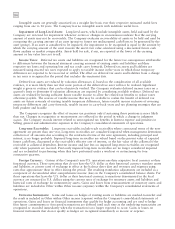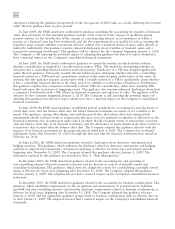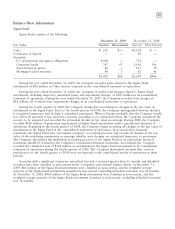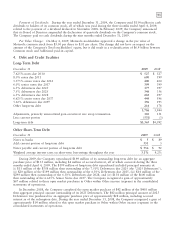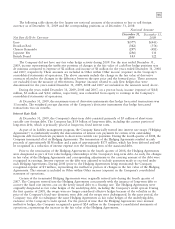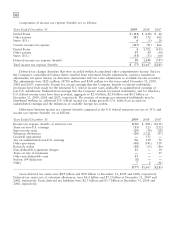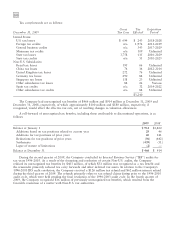Motorola 2009 Annual Report Download - page 102
Download and view the complete annual report
Please find page 102 of the 2009 Motorola annual report below. You can navigate through the pages in the report by either clicking on the pages listed below, or by using the keyword search tool below to find specific information within the annual report.
94
In October 2008, the Company repaid, at maturity, the entire $84 million aggregate principal amount
outstanding of its 5.80% Notes due October 15, 2008. In March 2008, the Company repaid at maturity, the
entire $114 million aggregate principal amount outstanding of its 6.50% Notes due March 1, 2008.
Aggregate requirements for long-term debt maturities during the next five years are as follows: 2010—
$531 million; 2011—$604 million; 2012—$405 million; 2013—$5 million; and 2014—$4 million.
Credit Facilities
In June 2009, the Company elected to amend its domestic syndicated revolving credit facility (as amended from
time to time, the ‘‘Credit Facility’’) that is scheduled to mature in December 2011. As part of the amendment, the
Company reduced the size of the Credit Facility to the lesser of: (i) $1.5 billion, or (ii) an amount determined based
on eligible domestic accounts receivable and inventory. If the Company elects to borrow under the Credit Facility, it
would be required to pledge its domestic accounts receivables and, at its option, domestic inventory. As amended, the
Credit Facility does not require the Company to meet any financial covenants unless remaining availability under the
Credit Facility is less than $225 million. In addition, until borrowings are made under the Credit Facility, the
Company is able to use its working capital assets in any capacity in conjunction with other capital market funding
alternatives that may be available to the Company. As of and during the year ended December 31, 2009, there were
no outstanding borrowings under this Credit Facility.
At December 31, 2009, the commitment fee assessed against the daily average amounts unused was 75 basis
points.
The Company’s current corporate credit ratings are ‘‘BBB-’’ with a negative outlook by Fitch Ratings
(‘‘Fitch’’), ‘‘Baa3’’ with a negative outlook by Moody’s Investors Service (‘‘Moody’s’’), and ‘‘BB+’’ with a stable
outlook by Standard & Poor’s (‘‘S&P’’).
5. Risk Management
Derivative Financial Instruments
Foreign Currency Risk
The Company uses financial instruments to reduce its overall exposure to the effects of currency fluctuations
on cash flows. The Company’s policy prohibits speculation in financial instruments for profit on the exchange
rate price fluctuation, trading in currencies for which there are no underlying exposures, or entering into
transactions for any currency to intentionally increase the underlying exposure. Instruments that are designated as
part of a hedging relationship must be effective at reducing the risk associated with the exposure being hedged
and are designated as part of a hedging relationship at the inception of the contract. Accordingly, changes in the
market values of hedge instruments must be highly correlated with changes in market values of the underlying
hedged items both at the inception of the hedge and over the life of the hedge contract.
The Company’s strategy related to foreign exchange exposure management is to offset the gains or losses on
the financial instruments against losses or gains on the underlying operational cash flows or investments based on
the operating business units’ assessment of risk. The Company enters into derivative contracts for some of the
Company’s non-functional currency receivables and payables, which are primarily denominated in major
currencies that can be traded on open markets. The Company typically uses forward contracts and options to
hedge these currency exposures. In addition, the Company enters into derivative contracts for some firm
commitments and some forecasted transactions, which are designated as part of a hedging relationship if it is
determined that the transaction qualifies for hedge accounting under the provisions of the authoritative
accounting guidance for derivative instruments and hedging activities. A portion of the Company’s exposure is
from currencies that are not traded in liquid markets and these are addressed, to the extent reasonably possible,
by managing net asset positions, product pricing and component sourcing.
At December 31, 2009, the Company had outstanding foreign exchange contracts totaling $1.7 billion,
compared to $2.2 billion outstanding at December 31, 2008. Management believes that these financial
instruments should not subject the Company to undue risk due to foreign exchange movements because gains and
losses on these contracts should generally offset losses and gains on the underlying assets, liabilities and
transactions, except for the ineffective portion of the instruments, which are charged to Other within Other
income (expense) in the Company’s consolidated statements of operations.


